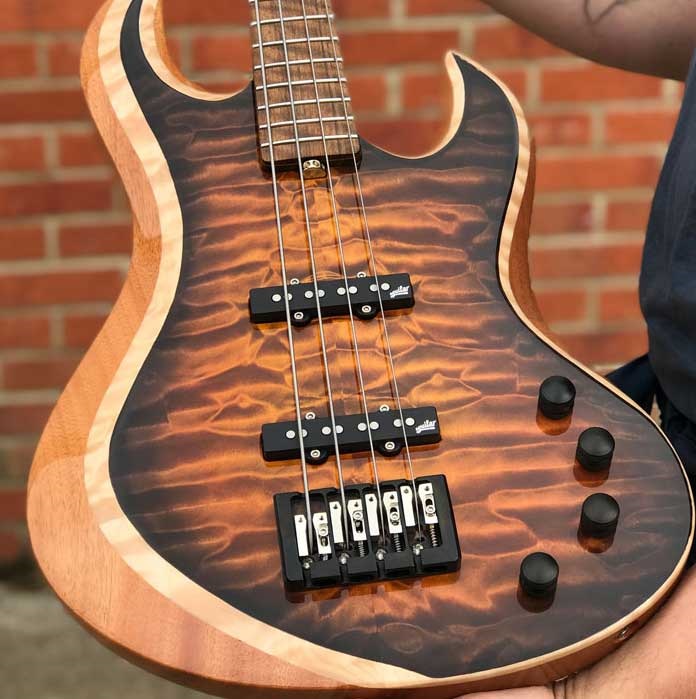Tuners: What Kind to Buy & How to Install Them (with Pictures)
Written by Evan, Best Bass Gear’s Prewire & Tech Support (Electronics and Hardware)


Before you change your tuner, you first have to find which replacement will work for your bass.
Fender basses use tuners which normally can be replaced by a Hipshot Vintage Tuner model, although some models are designed for an Ultralight tuner model. I recommend looking at the back of your headstock and comparing the shape of your tuner to the Vintage tuner shapes on our website or by looking at this diagram. If you cannot figure out which style to use, call me up or email me to ensure you’re not ordering the wrong part.
|
If you’re not using a Fender bass, many other basses use a smaller type of tuner which can be replaced by a Gotoh or Hipshot Ultralight tuner. When your bass has 5 or more strings I recommend using the Hipshot Ultralights to save on weight. It’s simple math: 5 Ultralights weigh the same amount as 4 Gotoh tuners.
Hipshot Vintage tuners have 1/2″ posts, Hipshot Ultralight tuners come in both 1/2″ and 3/8″ sizes, and Gotoh tuners have 3/8″ posts. To determine what size is right for your bass, follow one of these two easy steps:
-
- Remove a tuner and measure the hole that was drilled in the headstock
-
- a 3/8″ tuner will have a hole that is 9/16″ in diameter
- a 1/2″ tuner will have a hole that is 11/16″ in diameter
-
- Measure the nut that secures the tuner to the headstock. We are looking for the distance from one side of the nut to the other parallel side
-
- a 3/8″ tuner will measure roughly 9/16″ across
- a 1/2″ tuner will measure roughty 3/4″ across
more information on measuring your tuner’s
specific dimensions can be found here >>


Once you have purchased the right replacement tuners installation is quite easy. First, remove all strings on your instrument. You can then unscrew the tuner from the back of the headstock. Some tuners use 4 screws, while some modern tuners use a single screw. Modern tuners usually have a screw on bushing which you will need to unscrew with a socket or open end wrench (typically 9/16″, 3/4″ or 15mm). Vintage basses and Fenders will have a pressed in bushing where the tuner will slide out freely but then you must pull out the bushing or push from the back side to remove it.


If you’ve decided to install Hipshot Vintage tuners, you’ll have to lightly tap the new bushing into place either by using a rubber mallet or protect the bushing with scrap wood before tapping it in. After that, all you have to do is slide the tuner in from the back and screw in all four of the mounting points.
For Hipshot Ultralights and Gotoh tuners, you’ll have to drop the bushing into the tuner hole and then slide the tuner in from the back. Then, using a socket or wrench, turn the bushing to make it only finger tight. 1/2″ ultralights need a 3/4″ wrench, 3/8″ ultralights need a 9/16″ wrench, and Gotohs need a 15mm wrench. You can then screw in the one mounting point on the back and then tighten the tuner bushing fully, remaining cautious to not be overly tight.
From here, you simply need to continue replacing all others tuners, restring your bass, and play.
— Evan
BestBassGear.com’s Prewires & Tech Support (Electronics and Hardware)
sales@bestbassgear.com
877.839.3531





Guys,
Thanks for the info.
Be advised, that when changing tuners out to accomodate the Schaller BML type,a template may be required to locate the tuners so they are uniform.
The Schaller site does not provide this info and I could not find one available.(If you have any info – pass it along.The Schaller site does provide a Tech Drawing)
As such, I have made a template which will accept a .665 Dia.post and will locate the 2 pins of the BML design.
(Pix available of a bass in progress using the template)
Just letting you know.
Regards,
Lance Dietz
Dietz Guitar Services
I’m planning to soup up my aerodyne jazz bass with a Babicz “full contact” bridge, chrome jack plate, and chrome knobs. I also want to install beefy vintage Fender reverse tuners like the ones on my 1985 Marcus Miller Jazz. However it seems like the vintage pegs might be a bit larger than the ones on the aerodyne. Will I need to drill out the holes on the aerodyne headstock to make the vintage tuners fit?
I’d like to install the hipshot ultralite tuners on my BC Rich Classic Heritage Mockingbird bass. I’m turning it into a more ’70’s like bass(DiMarzio’s, passive electronics).It has the smaller type of tuners right now(smaller pegheads like on Ibanez or Warwick basses) but I’d like to install more vintage looking tuners (Gibson/ Fender-like) without havingbto drill bigger holes in the headstock. What type of Hipshot Ultralites should I order?
I like the ones you clip on the headstock. They’re accruate and fold back when not in use. I have an IntelliTouch which works nicely and also one I found on eBay (Musedo T-23) which I also like.References :
For us 5-string players, choices for brand and style can be limited, as my manufacturers and retailers only sell them in packs of 4. Which means you would have to pay full price for three extra tuners that you’ll never use.
Any suggestions on how to obtain singles or 5-sets of all brands?
Put all the tuners in the holes finger tight. Then lay a machinist’s straightedge along the flats and push them into line. Now mark where you’ll drill your retention holes.
Hi,is there a rule of thumb on how to position the machine heads?i have a cheap 6 string bass that i’m modifying and i noticed that the 3 tuners on the bass side are inclined downwards while the other 3 on the treble side are almost perpendicular.should i repositioned them?i’m not an expert on this,pls help.
Can anyone recommend tuners for the 5 string 2010 and up fender American deluxe jazz bass? I want to go for that vintage look with the fat barrel looking posts instead of the stock ones.
I have a bass with a 20mm thick headstock. Which kind of tuner can I use?
Hello, I recently got a 1976 Greco Bass and want to change the tuners, does anyone know what size I need? It has the clover leaf style now, and I want to change them to black? Thanks for the help